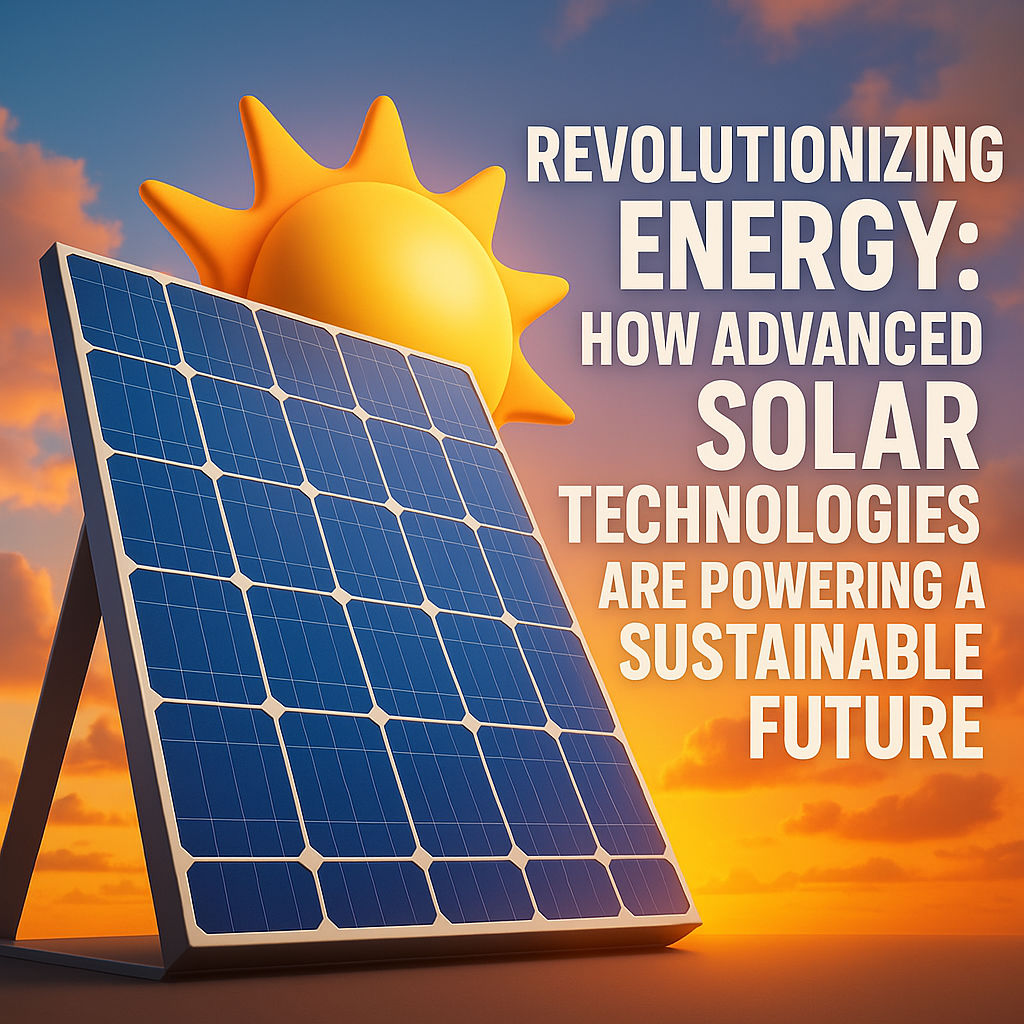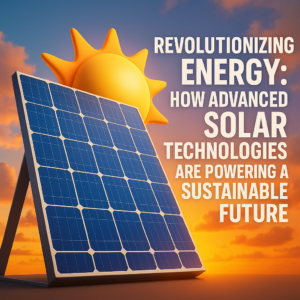Revolutionizing Energy: How Advanced Solar Technologies Are Powering a Sustainable Future

The utilization of solar energy through advanced breakthroughs enables sustainable development across the world.
Table of Contents
Introduction
Evolution of Solar Energy
Types of Advanced Solar Technologies
Photovoltaic (PV) Innovations
Big mirrors function as reflectors to direct light whenever sunlight requires action.
Perovskite Solar Cells
Bifacial Solar Panels
Thin-Film Solar Cells
Floating Solar Farms
Solar systems obtain thinking capabilities from smart technological communication systems.
Energy Storage Innovations
The system analyzes weather patterns to control the amount of power usage based on sunlight predictions.
Solar energy operates effectively for urban settlements and rural areas.
The rising number of solar panel installations creates additional business opportunities for the market.
Challenges and Limitations
The global community realizes how powerful solar energy currently serves as an important source of power.
Conclusion
1. Introduction
Solar energy together with other clean sources of energy must become essential because climate change and environmental damage require them. Of all renewable energy sources solar power presents the most extensive green and easily obtainable technology. Solar energy continues advancing toward cities-wide use through technological developments that moved solar panels from rooftop installations toward citywide power systems.
Solar technology advancesenable the conversion of sunlight into a more effective and sustainable and economical technique for energy production. This article investigates the solar energy evolution along with its transformative technologies which will become pivotal for sustainable global energy transformation.
2. Evolution of Solar Energy
Solar energy has been used since ancient times, but its modern development began in the 19th century. Photovoltaic cells brought a revolutionary change to solar energy production during the 1950s. Solar power started in space operations before finding its way to residential and industrial establishments.
Solar technology has experienced significant progression through the past three decades in terms of both efficiency and cost reduction and strength maintenance.
Contemporary photovoltaic systems obtain higher electric energy yields from sunlight despite requiring little sunlight for conversion.
The price of solar power decreased by more than 90% between 2010 and the current year.
The longevity of solar panels has reached 25–30 years because of minimal degradation in performance.
The emergence of advanced solar technologies will transform solar power collection and usage for this developing period.
3. Types of Advanced Solar Technologies
3.1 The use of perovskite materials enables solar panels to become more effective in their operation.
Most solar energy systems continue to rely chiefly on photovoltaic technology for their operation. Recent advancements include:
These solar panels have become the most durable electricity generation systems that the market currently utilises.
Multi-junction cells that capture more light spectrums
Nano-material coatings for better light absorption
The PV technology developed by SunPower and LONGi surpasses 24% efficiency while silicon possesses a theoretical threshold at about 29%.
3.2 The use of mirrors through CSP generates a point with concentrated sunlight.
The operation of CSP differs from PV panels because it utilizes mirrored systems to concentrate sunlight before directing it to a steam generating receiver for turbine power generation.
Advantages of CSP:
National power grids and major electricity systems integrate it without any problems.
Can store thermal energy for 24/7 power delivery
Your electricity generation rises under the same sun exposure.
Spain alongside the UAE has built significant CSP facilities which generate electricity to supply power to numerous domestic residences during nighttime hours.
3.3 Perovskite Solar Cells
The material known as perovskite shows potential as one of the most efficient compounds available for this purpose today.
Low-cost production
Traditional solar panels differ because they do not introduce bulk.
The solar panels show the ability to transform more than 30% of solar power into electrical energy.
The solution of durability limitations plus moisture sensitivity problems received progress alongside impressive accomplishments from perovskite-silicon tandem cells toward commercial viability.
3.4 Bifacial Solar Panels
These solar panels draw light energy through their two sides from direct front-facing sunlight in addition to reflected light that reaches their back portions.
Benefits include:
Up to 20% more energy output
Strong performance operations can be maintained under challenging environmental situations through these panels.
The increasing solar power industry employs these panels for fields and reflective city architecture.
3.5 Thin-Film Solar Cells
Thin-film cells consist of two main materials which include cadmium telluride (CdTe) and copper indium gallium selenide (CIGS).
Lightweight and flexible
Ideal for irregular surfaces
Less efficient than crystalline silicon but much cheaper
Organic photovoltaics serve locations that reject standard solar panels like portable electronic devices, automobiles, and building-integrated photovoltaics (BIPV).
3.6 Floating Solar Farms
Floating solar farms (also named floatovoltaics) get constructed on top of lakes along with reservoirs or oceans. They:
Save land space
Reduce water evaporation
Perform better due to cooler temperatures
The nations of China and Japan have enacted a strong leadership position regarding floating solar power plant implementation while focusing operations on towns and watergy supply areas.
4. A solar system that communicates with devices represents very good intelligence.
When integrated with smart grids solar systems eliminate their standalone operating condition. They connect to:
The smallest intelligent monitoring system monitors your solar system activities day and night.
Energy consumption levels get managed through smart meter systems
Artificial intelligence algorithms aid the power distribution by maximizing operational optimality.
The combined operation enables effective electricity transmission and distribution operations while maintaining a balanced power flow that minimizes unnecessary expenses.
5. Energy Storage Innovations
Solar power operates intermittently until storage systems turn it into continuous electricity throughout the day. Innovations include:
The solar setup’s power banks serve as strong sleek and intelligent battery units.
The combination of solid-state batteries creates safer compact storage units.
Hydrogen fuel cells
Thermal salt storage in CSP systems
Household solar systems will receive complete energy independence through integrated battery systems in upcoming years.
6. The system uses weather pattern predictabilities to enhance solar energy collection optimization.
Artificial Intelligence develops solar management through following key aspects:
Predicting energy demand
Monitoring system health
Forecasting solar irradiance
The modern solar power system can detect its own operational problems automatically.
Through machine learning algorithms utility companies acquire precise control of their substantial solar power systems to achieve reduced energy expenses.
7. Cities and rural areas both accept solar energy installations in equal measure.
Urban Applications:
Solar panels installed on building rooftops have converted properties into energy-producing facilities.
Solar parking lots with charging stations
Solar-powered streetlights
Building-integrated solar panels function as integrated components on walls while also being used on windows.
Rural Applications:
The usage of off-grid systems creates power supply for remote villages.
Solar-powered water pumps for agriculture
Portable solar lanterns replacing kerosene lamps
Solar energy usage leads to higher accessibility together with better equity standards and improved life quality standards.
8. Using solar energy systems helps protect the environment as well as create economic growth for the nation.
The job sector based on solar energy is currently expanding at an impressive rate throughout the world. According to IRENA:
A total of 4 million positions exist in the solar PV market (2023).
Solar energy benefits both domestic power supply and creates employment opportunities in the workforce.
Solar energy creates multiple work places throughout its life cycle that extends from production to engineering research and development worldwide.
9. Challenges and Limitations
Research on solar energy exhibits positive results although the technology still meets multiple barriers during its implementation.
The process of solar energy storage for future consumption presents high initial financial burdens.
High efficiency rates of solar panels diminish in periods of cloudy weather and rainfall.
Larger agricultural operations face problems with their required land spaces
Improve the recycling system for solar cell waste by establishing better infrastructure.
The establishment expenses become challenging to manage when governments do not offer subsidies.
The issues are being resolved through international collaborations between governments and scientists as well as comprehensive policy making.
10. The European Union directs its focus towards environmental sustainability as its primary objective ahead.
State and corporate entities allocate substantial funding to develop solar technology:
The target set by 2030 seeks to achieve almost 50% renewable energy use in electricity generation.
India plans to develop 500 GW of non-fossil fuel capacity before the year 2030.
The US Inflation Reduction Act includes major solar incentives
Future possibilities:
The combination of solar power generation that occurs through vehicle traffic on operational roads
Space-based solar stations transmitting energy via microwaves
Solar panel devices operate with automatic self-cleaning capabilities that do not require human intervention.
Solar energy is transitioning from an alternative choice to a mainstream power source because of increasing innovation speed.
11. Conclusion
The future no longer holds concepts of advanced solar technologies since they already drive present-day transformations in the energy landscape. The combination of perovskite materials with AI-controlled grids and floating power generation facilities through solar innovation results in a better sustainable future.
The world currently faces dual crises of energy shortages and environmental threats which solar power offers as a promising solution. These technologies allow people of all types to generate power without causing destruction to the planet.
Which format do you prefer between thumbnail design, PDF file and SEO tag implementation for this article?





